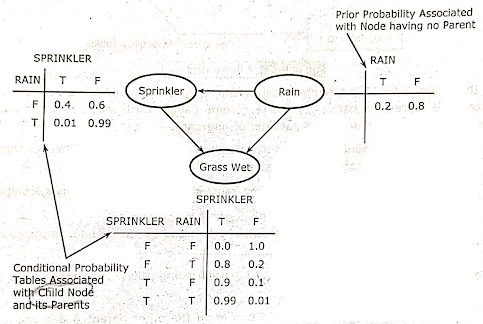PATTERNS OF INFERENCE IN BAYES NETWORK
- There are mainly three types of inference in Bayes network.
- Inorder to explain the patterns of inference let us consider an example Bayes network. The network is shown in the Fig. 3.5.1.
Fig 3.5.1: A Bayes Network
- In the above Figure. 3.5.1 M is the movement of arm, L is the term, which represents a block is liftable, B represents battery and G represents gauge which indicates when battery if full. Now we explain the three patterns of inference.
Causal or Top-down Inference:
Let us calculate P(M | L) that is the probability that the arm moves given that black is liftable.
- The arm can only be moved by the cause the block is liftable this calculation is an example of causal reasoning.
- P(M | L), L is called the evidence and M is called as query node, as the question is about the probability of M.
- Next chain rule is used. to condition M on the Other parent B and also L.
- P(M | L) = P(M | B, L) P(B | L) + P(M | ᆨB, L) P(ᆨB | L). As B has no parents
- P(B | L)= P(B), in the same way P(ᆨB | L) = P(ᆨB).
- ⇒ P(M | L) = P(M | B, L) P(B) + P(M | ᆨB, L) P(ᆨB)
from the above Figure, 3.5.1 these values are substituted,
- P(M | L) = 0.9 X 0.5 + 0 X 0.5 = 0.45
- ∴ P(M | L) = 0.45
The operations that are performed are.
- Rewriting the given condition probability of the query node Q in the form of joint probability of Q if evidence is given and the parents which are not evidence given the evidence.
- This point probability is expressed in the form of probability of Q which is conditioned on all of its parents.
Diagnostic or Bottom-up Inference
- Let us calculate that the block cannot be lifted if it is given that the arm can't move. i.e. P(ᆨL | ᆨM).
- Here an effect is used to infer a cause, so this is called diagnostic reasoning.
Now this can be converted into casual relationship like P(ᆨM | ᆨL) and the value can be used to find the P(ᆨL | ᆨM) as 0.63934.
Explaining Away
- If there is another evidence say ᆨB that the battery is not charged.
- Then this evidence explains, ᆨM, making ᆨL less certain.
- This inference uses bottom up reasoning in which top-down reasoning may be used.
- According to Bayes rule,
From the definition of conditional probability it implies.
As B has no parents P(ᆨB | ᆨL) =P(ᆨB)
From the above Figure. 3.5.1 the values can be taken and P(ᆨB, ᆨM) can be calculated as follows,


